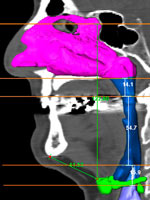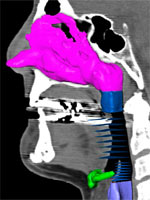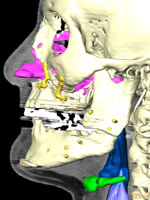



Significant widening of the respiratory passages
The analysis by Dr. Zachow of the Konrad-Zuse-Zentrum Berlin proved, with the help of a special 3-dimensional programme that allows the pre- and postoperative width of the respiratory passages to be seen and measured simultaneously, that the cross-sections of all sections of the respiratory passages were extended by rotation advancement strongly to very strongly. The orophrangeal extension was 95.08%, hypopharyngeal extension was 40.34%, and nasopharyngeal extension was 16.89%. It is important to mention that the respiratory passages were also laterally widened in the oropharyngeal plane by 65.22%, and in the hypopharyngeal plane by 24.5%. This resulted in a more elliptic form of the respiratory passages following rotation advancement.
Reduced flow resistance in the respiratory passages
An important discovery was that the upper respiratory passages, on the one hand, considerably widen and, on the other hand, become shorter after rotation advancement of the jaw, most notably in the oropharyngeal area by 1.507 cm, corresponding to a 27.96% shortening. The law of flow resistance in tubes applies here, indicating that the flow resistance is in proportion to the length of the tubular system. The shorter the tubular system, the lower the flow resistance; the shorter and wider the respiratory passages are, the easier it is to breathe.
The analysis by the Konrad-Zuse-Zentrum showed both that after rotation advancement of the jaw according to Professor Sailer the pre-/postoperative distance between tongue bone (os hyoideum) and skull base was reduced by 18.87% (2.31cm) and the angle between lower jaw – hyoid and cranial base was reduced from a preoperative 42° to a postoperative 16°, showing a difference of 26°.
These findings prove the efficiency of the technique of jaw adaption osteotomy developed by Professor Sailer using rotation advancement in the case of sleep apnoea. To date, it has been possible to cure all cases with a normalisation of oxygen saturation in the blood during sleep. In addition the physical and mental performance of the patients improved during the day too, which can also be attributed to the permanently widened respiratory passages. At the same time, an increase in attractiveness of the patients’ facial features takes place, is operatively inherent and cannot be avoided.
What is the gold standard for treating an illness?
By “gold standards” one can only mean the best possible, scientifically safe treatment which, in an optimal case, achieves a cure for the suffering.
For a long time the CPAP treatment was regarded as the “gold standard” for obstructive sleep apnoea and snoring. This treatment had the advantage that better sleep quality was quickly achieved. It was not possible for the device to achieve a cure, and this was not envisaged. CPAP devices therefore represent a purely symptomatic treatment method which does not eliminate the cause of the suffering.
A cure for obstructive sleep apnoea and snoring, i.e. elimination of the cause, can only be achieved by widening the upper, i.e. the oropharyngeal respiratory passages which are too narrow.
The cause of the obstructive sleep apnoea is almost always the receding lower and upper jaw, caused by a growth disorder. For 20 years there have been operative techniques for the routine advancement of the lower and upper jaw which automatically lead to widening of the respiratory passages and which cure obstructive sleep apnoea.
The technique of “rotation advancement of the lower and upper jaw” developed by Professor Sailer at the University of Zurich guarantees widening of the upper respiratory passages and leads to a cure for obstructive sleep apnoea and snoring.
The 3-dimensional widening of the upper respiratory passages by rotation advancement according to Professor Sailer has been scientifically proved by the renowned Konrad-Zuse-Zentrum. The scientific results were published in the International Journal of Oral and Maxillofacial Surgery.
“Rotation advancement” of the lower and upper jaw is the new “gold standard” for the treatment of obstructive sleep apnoea and snoring.





 )
)